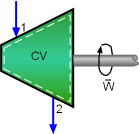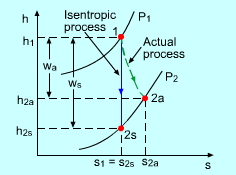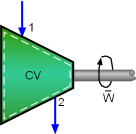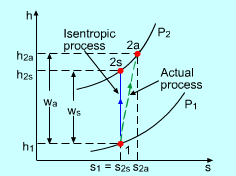| Ch 6. Entropy | Multimedia Engineering Thermodynamics | ||||||
| Entropy | Tds Relations |
Entropy Change |
Isentropic Process |
Isentropic Efficiency |
Entropy Balance (1) |
Entropy Balance (2) |
Reversible Work |
| Isentropic Efficiency | Case Intro | Theory | Case Solution |
| Chapter |
| 1. Basics |
| 2. Pure Substances |
| 3. First Law |
| 4. Energy Analysis |
| 5. Second Law |
| 6. Entropy |
| 7. Exergy Analysis |
| 8. Gas Power Cyc |
| 9. Brayton Cycle |
| 10. Rankine Cycle |
| Appendix |
| Basic Math |
| Units |
| Thermo Tables |
| eBooks |
| Dynamics |
| Fluids |
| Math |
| Mechanics |
| Statics |
| Thermodynamics |
| ©Kurt Gramoll |
| |
||
| Entropy Change of Pure Substance
|
||
In engineering analysis, isentropic efficiency is a parameter to measure the degree of degradation of energy in steady-flow devices. It involves a comparison between the actual performance of a device and the performance that would be achieved under idealized circumstances for the same inlet and exit states. Although there exits heat transfer between the device and its surroundings, most steady-flow devices are intended to operate under adiabatic condition. Hence, normally an isentropic process is chosen to serve as the idealized process. Recall, if the inlet is denoted by subscript 1 and exit is denoted by subscript 2, the energy balance for a one-inlet-one-exit control volume is
|
||
| Isentropic Efficiency of Turbines
|
||
|
|
For an adiabatic turbine which undergoes a steady-flow process, its inlet and exit pressures are fixed. Hence, the idealized process for turbine is an isentropic process between the inlet and exit pressures. The desired output from a turbine is the work output. Hence, the definition of isentropic efficiency of turbine is the ratio of the actual work output of the turbine to the work output of the turbine if the turbine undergoes an isentropic process between the same inlet and exit pressures. ηT = Actual turbine work/Isentropic
turbine work wa and ws can be obtained from the energy balance of the turbine. Usually the kinetic and potential energies associated with a process through a turbine is negligible compared with the enthalpy change of the process. In this case, the energy balance of the turbine is reduced to The isentropic efficiency of turbine can then be written as ηT where |
|
| Isentropic Efficiency of Compressors and Pumps
|
||
Compressors and pumps, when undergo a steady-flow process, consume power. The isentropic efficiency of a compressor or pump is defined as the ratio of the work input to an isentropic process, to the work input to the actual process between the same inlet and exit pressures. ηC = Isentropic compressor (pump) work/Actual compressor (pump) work |
||
|
|
wa and ws can be obtained from the energy balance of the compressors or pumps. When the kinetic and potential energies associated with a gas flowing through a compressor are negligible compared with the enthalpy change of the gas, the energy balance of the compressor is reduced to The isentropic efficiency of a compressor becomes η C Pumps are used to handle liquid instead of gas. Since liquid is incompressible and the process is an isentropic process, the enthalpy change from inlet to exit is |
|
 Schematic of a Pump |
If the kinetic and potential energies are negligible, the isentropic efficiency of a pump is reduced to η P IN practice, compressors are intentionally cooled to minimize the work input. In those cases, a reversible isothermal process is served as the idealized process for compressors which are intentionally cooled, and then an isothermal efficiency is defined instead of the isentropic efficiency. The isothermal efficiency is defined as the ratio of the work input to the isothermal process, to the work input to the actual process between the same inlet and exit pressures. ηC =
Reversible isothermal compressor work/Actual
compressor work |
|
| Isentropic Efficiency of Nozzles
| ||
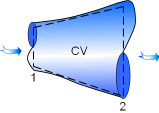 Schematic of a Nozzle 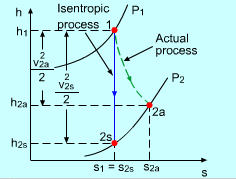 h-s Diagram of the Actual and Isentropic Processes of an Adiabatic Nozzle |
Nozzles are devices used to accelerate the fluid velocity at the cost of pressure. The isentropic efficiency of nozzles is defined as the ratio of the actual kinetic energy at exit to the kinetic energy at the exit when the process is isentropic for the same inlet and exit pressures. ηN =
Actual KE at exit/Isentropic KE at exit There is no work interaction involved in nozzles and the potential energy change of the fluid is small. If the inlet velocity is small relatively to the exit velocity, the energy balance of a nozzle is reduced to Then the isentropic efficiency of nozzles becomes ηN |
|

